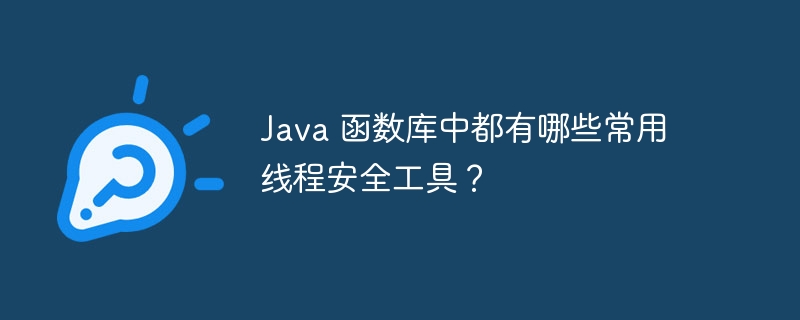Home >Java >javaTutorial >What are the commonly used thread safety tools in Java function libraries?
What are the commonly used thread safety tools in Java function libraries?
- PHPzOriginal
- 2024-05-03 09:21:01460browse
The Java function library provides thread-safe tools for multi-thread programming, including: Thread-safe collections: ConcurrentHashMap, ConcurrentLinkedQueue, CopyOnWriteArrayList Atomic variables: AtomicInteger, AtomicLong, AtomicReference Read-write locks: ReentrantLock, ReadWriteLock Synchronizers: CountDownLatch, Semaphore, CyclicBarrier These tools ensure safe access and updates to shared resources in a multi-threaded environment, preventing data inconsistencies and race conditions.

Commonly used thread safety tools in Java function libraries
In multi-threaded programming, thread safety is crucial to prevent Parallel execution leads to inconsistent state. Java libraries provide a wide range of thread-safety tools to help developers implement thread-safe and efficient applications.
Thread-safe collection
- ConcurrentHashMap: A concurrent hash table that provides efficient read and write operations and thread safety.
- ConcurrentLinkedQueue: A concurrent linked list that supports fast enqueueing and dequeuing as well as thread-safe access.
- CopyOnWriteArrayList: A concurrent array list with separate reading and writing. Each write operation will create a new copy of the list.
Atomic variable
- AtomicInteger: An atomic integer that supports thread-safe increment, decrement, and comparison operations.
- AtomicLong: An atomic long integer that provides the same thread-safe operations as AtomicInteger.
- AtomicReference: An atomic reference that supports thread-safe access and update of the reference type.
Read-write lock
- ReentrantLock: A reentrant lock that allows a thread to reentrant multiple times after acquiring the lock. Enter the same critical section.
- ReadWriteLock: A read-write lock that allows multiple threads to read shared data at the same time, but only one thread can write at a time.
Synchronizer
- CountDownLatch: A synchronizer that waits for a specific event to occur.
- Semaphore: A synchronizer used to control the number of concurrent threads.
- CyclicBarrier: A synchronizer used to coordinate threads to wait at the barrier.
Practical case
Consider a multi-threading scenario where multiple threads need to access shared data stored in a hash map. To ensure thread safety, you can use a ConcurrentHashMap and update it via a synchronized block:
import java.util.concurrent.ConcurrentHashMap;
public class ThreadSafeHashMap {
private ConcurrentHashMap<String, Integer> sharedData = new ConcurrentHashMap<>();
public void updateData(String key, int value) {
synchronized (sharedData) {
sharedData.put(key, value);
}
}
}In this way, every time an update is made to the hash map, only one thread can access it, thus avoiding race conditions and The data is inconsistent.
The above is the detailed content of What are the commonly used thread safety tools in Java function libraries?. For more information, please follow other related articles on the PHP Chinese website!

